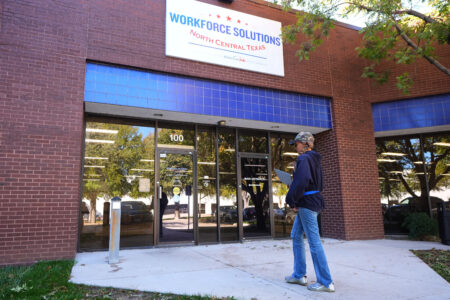From fire departments to hospitals, hundreds of first responder stations face a serious flood risk
In the West Virginia town of Triadelphia, the rain had stopped, and the sun had come out.
But then, emergency calls began pouring in. People were trapped in their cars. As Triadelphia Fire Chief David Patterson and his crew tried to respond, a flooded bridge blocked their path.
“I looked up, and there’s a wall of water coming at us,” Patterson said.
The scattered June storms earlier this year pummeled West Virginia’s northern panhandle, dropping several inches of rain in mere minutes. The heavy rainfall quickly ran off the hills surrounding Triadelphia. Rivers of water gushed through the region, killed nine residents and washed away cars, homes and bridges.
As Patterson and his crew rescued stranded residents, the floodwaters ravaged their fire station.
Water built up against the back wall of the firehouse, eventually bursting through and flooding the station, wrecking the volunteer fire department’s office and maintenance rooms and washing away hoses, air packs and 30 years’ worth of tools.
“It took everything in the firehouse with it,” said Patterson.
The station has never flooded before, but the risk had been identified nearly 20 years ago.
The Triadelphia station is located in a high-risk flood zone. And it’s one of almost 200 fire stations in West Virginia that face a significant risk of being flooded each year.
Fire departments, police stations, schools, hospitals and nursing homes are the state’s essential facilities. A quarter of all essential facilities in West Virginia face a moderate-to-significant risk of flooding each year.
“West Virginia is under a very high degree of flood risk as a state,” said Mathew Sanders, a disaster planning expert at Pew Charitable Trusts. “And that risk is continuing to grow.”
One in three fire stations face significant flood risks
About one-third of all fire departments in West Virginia face a moderate-to-high risk of flooding every year, according to data compiled by the researchers from the West Virginia GIS Technical Center.
Using data and flood maps issued by the Federal Emergency Management Agency, researchers created the West Virginia Risk Explorer to help assess, analyze and visualize the flood risk in communities across West Virginia.
West Virginia’s mountainous terrain and thousands of rivers and creeks — along with decades of strip mining and timbering — make the state especially vulnerable to flooding. This is likely to get worse as climate change continues to increase the risk.
Most of the nearly 200 fire stations are located in areas designated as high-risk flood zones.
And 14 of them are particularly vulnerable because they are located in areas closest to a river or floodway. These areas are typically kept clear to allow water to rush through unobstructed during a flood event to prevent the water from rising or moving into the community.
“It just further underlines why West Virginia needs to really take its flood problem seriously,” said Sanders.
Flood zones change as FEMA redraws its maps to more accurately reflect the risk communities face, which can place buildings and people in high-risk areas.
Many fire stations in West Virginia were built before those areas were identified, so they weren’t required to adhere to flood building regulations.
The enforcement of building standards aimed at reducing or preventing flood damage was “a little lax prior to 2004,” said Dave Weaver, Ohio County planning officer and floodplain manager.
“That’s why we got to come in and be the bad guy a lot of times,” he added.
Each of West Virginia’s 55 counties has a designated floodplain manager, who is responsible for helping reduce future flood damage. So do 279 municipalities, although many communities share the same one.
“Smaller municipalities can’t afford to just have a floodplain manager, so whoever the floodplain manager is, is wearing four or five different hats,” said Ray Perry, president of the West Virginia Floodplain Managers Association.
Perry himself serves as Logan County’s code enforcement officer in addition to the county’s floodplain manager. Others also serve as emergency and planning managers. And for at least 40 municipalities, the community’s floodplain manager is their mayor, according to a contact list maintained by the GIS center.
The state’s flood plan, which was updated last year, offers a wide range of ideas to protect West Virginians from flooding.
The plan’s 12 general potential actions include educating local and county officials on flood mitigation and floodplain management and improving the enforcement of flood-related ordinances.
It also includes establishing a program to help floodproof or relocate buildings at risk, like the fire stations and other essential structures.
However, the state agency tasked with updating and implementing the state’s flood plan has remained unfunded, and it’s not clear how the office can implement any of the proposals.
Flooding teaches prevention the hard way
In 2017, floods that devastated communities across the northern part of the state also inundated the Hundred Volunteer Fire Department’s newly built fire hall.
Five feet of muddy water poured into the building, damaging the hall the department spent more than two years raising money to build. The floodwaters claimed four trucks and thousands of dollars’ worth of equipment.
It took the department nearly a year to restore all the equipment that they had lost.
The emergency generator now sits four feet higher than it previously did. The files are housed on the station’s second floor. And if heavy rain begins, the crew grabs their gear, takes the trucks and gets to high ground.
“Just like anything else, you learn from your calls,” said Tom Powell, chief of the Hundred Fire Department.
The year prior, both the Rainelle and Clendenin fire stations were engulfed by water during the deadly 2016 floods. And decades before that, in 1985, the Marlinton fire station was submerged with seven feet of floodwater, destroying all the firehouse’s equipment.
In Pocahontas County, when the Greenbrier River and Knobbs Creek begin to rise, the Marlinton fire department now moves its equipment out of reach. In the station itself, files, records and anything of importance have been moved upstairs.
The community has also used those lessons to inform preparedness and evacuation plans. Now, they have a flood fact sheet that tells residents what steps to take based on the height of the river.
“That’s been a plan put in place over several years. It really started with that ’85 flood,” said Benjamin Brown, Pocahontas County emergency management director.
The Delbarton Volunteer Fire Department in Mingo County has never flooded before. But both their main and substations are among the most vulnerable of the 186 stations in West Virginia that face a significant risk of flooding.
Both buildings sit right on the banks of Pigeon Creek, which are crumbling because of repeated flooding, said Jordon Mounts, a lieutenant with the fire department.
The department has floated the idea of relocating its station, in part, due to its proximity to the creek and risk of flooding. However, nothing has materialized due to a lack of funding.
The station’s budget is already stretched thin with its current maintenance, equipment and upkeep costs, so building a station outside the floodplain “is very, very difficult to do,” Mounts said.
“The fire station is kind of the heart of the community,” Mounts added. “Anytime there’s a natural disaster of any kind, people don’t look to city hall for that. They look to the fire department.”
___
This story was originally published by Mountain State Spotlight and distributed through a partnership with The Associated Press.




